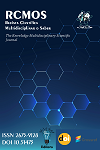“Skin-colored pencil”: diversity or exclusion?
“Skin-colored pencil”: diversity or exclusion?
DOI:
https://doi.org/10.51473/rcmos.v1i1.2025.862Keywords:
Early childhood education; Afro-descendants; diversity; skin-colored pencils; literacy.Abstract
This study examines the representation of artistic materials used in early childhood education, focusing on "skin-colored pencils" during the literacy process. The research, based on direct and participatory observation with children in school contexts, highlights the importance of working on diversity from childhood. Materials that consider different skin tones can positively influence the development of identity, self-esteem and social interaction in children, in addition to fostering a broader understanding of ethnic diversity. The research is justified by the need to build an inclusive society from the early school years. The results highlight the urgency of mobilizing the school community to adopt and disseminate materials that represent ethnic plurality in classrooms. To understand more about the subject, we will talk to authors such as CRUZ (2018), GOMES (2017), GUIMARÃES (2009), LINDEN (2018) and OLIVEIRA (2017), who served as the basis for the studies on the topic addressed. The discussion focuses on the importance of promoting discussion/dialogue to enable the development of literacy activities that awaken students' interest in investigating ethnic varieties from the early grades. Promoting activities that awaken children's interest in ethnic diversity from the early grades is essential, and for this, the continuous engagement of educators, managers, parents and policy makers is necessary, in order to minimize the impacts of racism in the school environment and ensure a more inclusive and equitable early childhood education.
Downloads
References
ALMEIDA, S. Racismo Estrutural. São Paulo: Pólen, 2019. 264p
BELL HOOKS. Olhares Negros: Raça e Representação. Editora Elefante, 1992.
CARNEIRO .Aparecida Sueli. A Construção do Outro como Não-Ser como fundamento do Ser. Feusp, 2005.
CAVALLEIRO, E. Do Silêncio do Lar ao Silêncio Escolar. Contexto, 2001.
COLELLO, S. G.; SILVA, M. S. “Alfabetização e formação de educadores”. In: LAUAND, J. (org.) Filosofia e Educação – Estudos 12. São Paulo: Factash, 2012.
COLLINS, Patricia Hill . Interseccionalidade [recurso eletrônico] / Patricia Hill Collins, Sirma Bilge ; tradução Rane Souza. - 1. ed. - São Paulo: Boitempo, 2020.
CRUZ, Elisabete. Cor de pele. Ilustrado por Rafael Duque. São Paulo: Suinara, 2018.
FANON, F. Pele Negra, Máscaras Brancas. Editora Ubu, 1952.
FERREIRO, Emilia. Reflexões sobre alfabetização . 26. ed. - São Paulo: Cortez, 2011.
FRANKENBERG, R. White Women, Race Matters: The Social Construction of Whiteness. University of Minnesota Press, 1993. DOI: https://doi.org/10.4324/9780203973431
GOMES, Nilma Lino. A Construção do Outro na Escola. Autêntica, 2017.
GOMES, Nilma Lino. Educação e relações raciais: refletindo sobre algumas estratégias de atuação. Brasília: MEC,2005.
GOMES, Nilma Lino. O movimento negro educador: saberes construídos nas lutas po emancipação. Petrópolis: Vozes, 2017.
GUIMARÃES, Antônio Sérgio Alfredo. Racismo e antirracismo no Brasil. 3ª. ed. São Paulo: Editora 34, 2009.
HALL, S. A Identidade Cultural na Pós-Modernidade. DP&A, 1997.
HALL, Stuart. "Quem precisa da identidade?". In: ______. Identidade e diferença. A perspectiva dos Estudos Culturais. 4.ed. p. 103-133. Petrópolis: Vozes, 2005.
HOOKS, B. Ensinando a transgredir: a educação como pratica da liberdade. São Paulo: Editora WMF Martins Fontes,2013.
LINDEN, Sophie Van der. Para ler o livro ilustrado. São Paulo: SESI-SP, 2018.
MEC. Compromisso nacional criança alfabetizada. Brasília. DF: MEC/GOVERNO FEDERAL, 2025.
MEC. Diretrizes Curriculares Nacionais para a Educação das Relações Étnico Raciais e para o Ensino de História e Cultura Afro-Brasileira e Africana. Brasília.DF: MEC/SEPPIR/SECAD, 2004.
MORTATTI, M. R. L. Os sentidos da alfabetização. São Paulo: Ed. UNESP; CONPED, 2000. DOI: https://doi.org/10.7476/9788539302697
OLIVEIRA, Sueli Ferreira. Lápis cor de pele. Ilustrado Gilmar e Fernandes. São Paulo: Casa Publicadora Brasileira, 2017.
VYGOTSKY, L. A Formação Social da Mente. Martins Fontes, 1989.
Downloads
Additional Files
Published
Issue
Section
Categories
License
Copyright (c) 2025 Ayla Micéia dos Santos Araújo, Alessandra Raniery Araújo Alves de Sousa, Marcieva da Silva Moreira, Odilanir de Oliveira Leão, Caryne Maria da Silva Gomes (Autor/in)

This work is licensed under a Creative Commons Attribution 4.0 International License.












